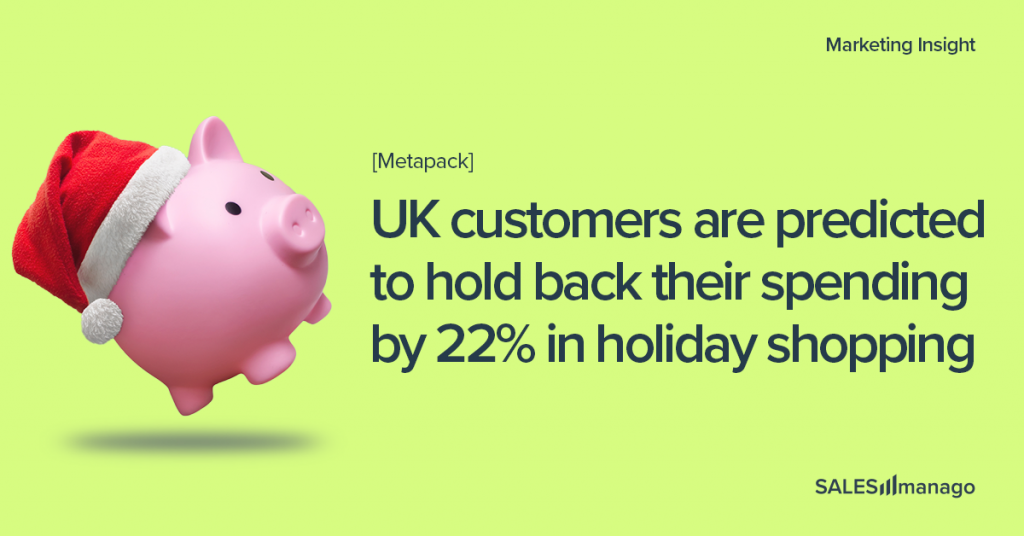
Black Friday this year will be 2022 in a nutshell. The Internet is bursting at the seams with predictions and strategies. In this article, we present you with six of the most prevalent, relevant, or simply interesting ones. We also present you with our take on them. But, most importantly, we suggest what to do about them.
Honorable mentions include toys will go like hot cakes, clothes will sell better than electronics, sales will start early, happen often, and last longer.
You are probably an experienced marketer who knows Black Friday inside out. We will not bore you with unnecessary details. Instead, we decided to point out a few interesting expectations for eCommerce on Black Friday 2022 that experts have frequently noted. These expectations suggest that Black Friday has evolved so that it is no longer just about the prices. We have observed an increasing role of values, Customer Experience, trust, and, finally, Customer Intimacy.
1. You will offer the best deals . . . or the highest prices ever
Internet predicts
Even with skyrocketing inflation, prices will be better than last year—so goes one common prediction. This prediction is based on the assumption that the supply chain issues plaguing eCommerce last year will not impact this year’s sales. Some have observed that this year, many retailers, including Walmart, Target, Gap, Nordstrom, Macy’s, and Kohl’s, have a glut of inventory. If they cannot unload it in the coming month, which is unlikely, they will likely offer it at steep discounts on Black Friday and Cyber Monday. Consequently, customers should expect Black Friday–level savings in addition to “official” promotions.
However, we cannot ignore the impact inflation will have on deals. “Stores are suffering,” says Priya Raghubir, professor of marketing at New York University’s Stern School of Business. “Their fixed costs remain high, and the revenue is shrinking. So they can’t afford to offer deep deals.”
Inflation has hit some specific categories of goods harder than others. For example, food prices have increased more than clothing prices. Shoppers may find that the quality of deals depends on what they buy.
Our take on it
Of course, how you set Black Friday prices varies greatly depending on your industry. It is unrealistic to expect that your inventory in energy carriers or top-tier graphic cards will expand, while fashion and clothing eCommerce will be in an entirely different situation.
In this case, your transparency and honesty in communication with customers will be important. We will elaborate on this later in this article, but trust is the key. If you can’t afford steep discounts, don’t make hasty promises. Instead, focus on the quality of service. A brilliantly executed, hyper-personalized campaign based on genuine knowledge about customers’ needs will not only carry you through Black Friday but also strengthen your efforts to achieve Customer Intimacy with your clients.
2. You won’t break any record . . . or reach $158 billion!
Internet predicts
Future Publishing predicts that Black Friday will raise $158 billion in sales this year. The study projects that 76% of American consumers plan on shopping for deals on Black Friday with an average budget of $574. Even though the Black Friday tradition has been expanded to other countries, US consumers are still among the biggest spenders. This year, according to Adobe, year-over-year online sales are predicted to increase by 2.8%, reaching $34.8 billion overall.
Others are more reserved in their predictions. Although Black Fridays and Cyber Mondays have typically seen sales records, we should not expect them this year. While it is true that Cyber Monday set a record for online sales for that single day last year, Black Friday sales decreased for the first time. Additionally, customers are pulling back from unnecessary purchases and spending less in general.
In addition, in 2022, sales in eCommerce are expected to go down for the first time. And we also should not forget the differences between the United States and Europe. Countries such as the United Kingdom are expected to see a shrink in holiday spending. According to a report by Metapack, UK shoppers are predicted to hold back their spending by 22%, with a $5.05 billion cutback in holiday shopping.
Our take on it
Breaking sales records in the case of European eCommerce seems unrealistic. This outlook, of course, will push CMOs and marketing teams to do anything to prove otherwise. We strongly dissuade from bullying customers with spray-and-pray strategies.
Clothing and toys are expected to sell better than electronics this year, even, or should we say, especially if your industry has been disfavored in 2022, you will gain the most by planning your campaign according to Lean Marketing principles. Hitting precisely will, at the end of the day, cost you much less, leaving much more room for profit.
3. You will provide value – and values
Internet predicts
Since the beginning of the pandemic, we have seen customers’ growing preference for a frictionless buying experience. They gravitated toward online shopping and curbside pickup. It is expected that in 2022, they will go even further in seeking comfort, convenience, and lower prices, which can all be provided much more easily by eCommerce than by retail.
While seeking value in the face of inflation is an obvious strategy, what about values? Research by Sprout Social reveals that nearly 72% of shoppers want brands to contribute positively to society. After employee and customer treatment, a company’s sustainability practices are the topmost factor influencing buying decisions. Actually, the most renowned research and consulting agencies perceive the demand for sustainability as an obvious megatrend.
Our take on it
While eCommerce is arguably much greener than retail, and you should ensure that your Black Friday campaigns do not let your customers forget this. Let the message about your sustainability initiatives sink in.
Chances are that you are utilizing zero-party data. If you are, the Black Friday campaign is a great opportunity to inform your customers that your business is based on the greenest, most ethical datasets possible for 2022. If you are looking for specific arguments concerning this matter, you will find them here.
4. You will be trustworthy and provide an excellent Customer Experience
Internet predicts
Except for last year, Black Friday and Cyber Monday sales have traditionally increased annually. However, the number of shoppers has decreased simultaneously. For instance, from 2019 to 2021, the number of shoppers attending those sales dropped by 15%.
One reason for this decrease is the extended time allotted for sales. Another important reason is much more grievous: customers no longer believe that the best prices are on those days. According to a survey of 1,000 UK shoppers, 62% said they didn’t think Black Friday prices were any lower than they were the rest of the year.
And they’re not wrong. In a 2019 study, just 5% of Black Friday sales offered a lower price than what was available during other times of the year. Such pricing may have helped create a lack of interest in Black Friday and Cyber Monday among many customers.
Our take on it
As we wrote earlier in this article—do not jeopardize the trust customers have in your business by making empty promises. Offer genuinely good prices that aren’t just overly exaggerated sales pitches. If you can’t, focus on Customer Experience. Providing honest information about 2022 prices, with a hyper-personalized experience will pay off well beyond Black Friday.
5. You will be generous to loyal customers
Internet predicts
It comes as no surprise that experts see increasing Customer Retention as a viable strategy to counter the effects of inflation.
“Consumers that are members of loyalty programs will probably really benefit from exclusive offers, early access to sales, special discounts, gifts with purchase and all sorts of other types of benefits,” says Heather Dougherty, the vice president of success at Lexer, a customer data platform for retailers. This observation also holds true for eCommerce.
Our take on it
We see this as an absolute no-brainer. The Customer Intimacy principle demands rewarding long-lasting partners with special care.
Moreover, offering discounts to loyal customers provides an opportunity to gather more valuable zero-party data. In this article, we describe one such use case in which an email and a landing page are used together to collect product preferences.
6. You will enable to buy now and pay later
Internet predicts
CNBC reported that, according to Salesforce data, the use of buy-now, pay-later (BNPL) payment methods during Cyber Week 2021 increased globally by 29% from the previous year. Due to this growing interest among consumers, the experts at blackfriday.com expect retailers to promote their BNPL programs intensively around Black Friday, even linking promotions to their use.
Our take on it
If you have not integrated the BNPL method yet, do it ASAP. We have strongly advocated this payment method since 2021 because it reflects our philosophy of making online shopping as customer-centric as possible, thus strengthening the bond between eCommerce and its customers. In fact, in this era of persistent inflation, it may mean the difference between a deal maker and a deal breaker.
So how do you prepare for Black Friday 2022?
It turns out that the obvious pricing techniques that have given Black Friday fuel for so long may not do the trick in 2022. Maybe you fell hostage to the realities of the supply chain and the state of your inventory. Maybe your customers no longer find the pricing techniques you have relied on trustworthy. Or maybe you will do just fine by offering solid deals.
In any case, it is worth remembering that Black Friday 2022 will demand more personalization, more trust, and a stronger bond than ever. It may turn out to be as much about Customer Experience and Customer Retention as it is about prices.

 Follow
Follow
















